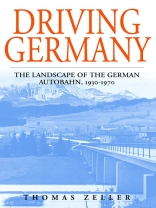Published in Association with the German Historical Institute, Washington, D.C.
Hitler’s autobahn was more than just the pet project of an infrastructure-friendly dictator. It was supposed to revolutionize the transportation sector in Germany, connect the metropoles with the countryside, and encourage motorization. The propaganda machinery of the Third Reich turned the autobahn into a hyped-up icon of the dictatorship. One of the claims was that the roads would reconcile nature and technology. Rather than destroying the environment, they would embellish the landscape. Many historians have taken this claim at face value and concluded that the Nazi regime harbored an inbred love of nature. In this book, the author argues that such conclusions are misleading. Based on rich archival research, the book provides the first scholarly account of the landscape of the autobahn.
表中的内容
Illustrations
Acknowledgments
Chapter 1. Introduction: Germany and its Autobahn
A growing overlap: history of technology and environmental history
Transportation history: the system of mobility
Chapter 2. Landscape: the Dual Construction
Physically altered landscapes
Culturally altered landscapes
Chapter 3. The Historical Habitat of Landscape-Friendly Roads
The autobahnen in environmental history
Building technological landscapes on the Rhine and Neckar
Reconciling nature and technology in the interwar period
Alwin Seifert and Fritz Todt: a biographic constellation
Chapter 4. Planning the Autobahn before and after 1933
The failed autobahn project of the interwar period
Building the Nazi autobahn
The place of the autobahn in the Nazi dictatorship
Propagandizing the Reichsautobahn
German Technology (Deutsche Technik) and the Reichsautobahn
Chapter 5. Conflicts over the Harmonious Road
Finding a niche for landscape architects
Searching for a job description
Pitting landscape architects against civil engineers
Marginalizing conservation and spatial planning on the autobahn
Legalizing the exclusion of conservation
Chapter 6. The Myth of the Green Autobahn
Road alignment as a subject of controversy
“One drives faster than I can write”: visual consumption on the Reichsautobahnen
The flora of the Nazi autobahn: contesting native plants
An ideology disintegrates: technology in the crisis of 1937
The value and cost of landscaping
The landscape advocates seek power beyond the autobahn
Chapter 7. Reinterpretations: the West German Autobahn, 1949 to 1970
Autobahnen and the politics of the Bonn Republic
Building a federal highway system
The postwar trust in numbers
“An autobahn is not a hiking path”: roadside plantings as safety devices
Roadside greenery as a bone of public contention
Chapter 8. Conclusion
Bibliography and Sources
Index
关于作者
Thomas Zeller is an associate professor at the University of Maryland, College Park, where he teaches the history of technology, environmental history, and science and technology studies. He is the author of Strasse, Bahn, Panorama (2002) and has co-edited the volumes How Green Were the Nazis? Nature, Environment, and Nation in the Third Reich (2005), Germany’s Nature: Cultural Landscapes and Environmental History (2005), The World Beyond the Windshield: Roads and Landscapes in the United States and Europe (2008) and Rivers in History: Perspectives on Waterways in Europe and North America (2008). His current research project, consuming Landscapes, has been supported by the National Science Foundation, the John W. Kluge Center at the Library of Congress, and the Program in Garden and Landscape Studies at Dumbarton Oaks.












